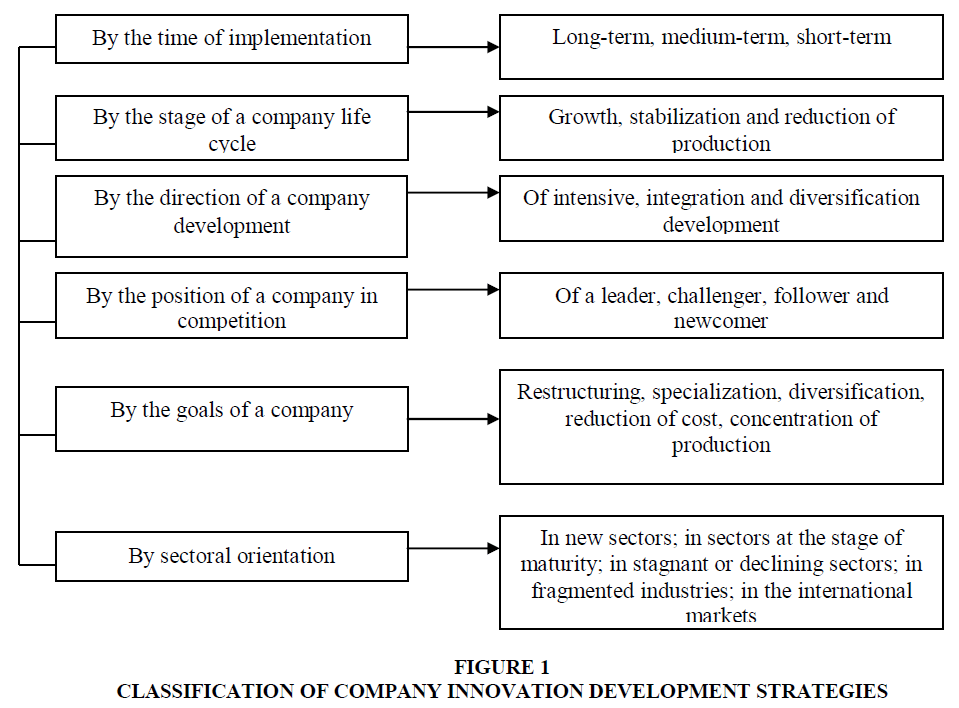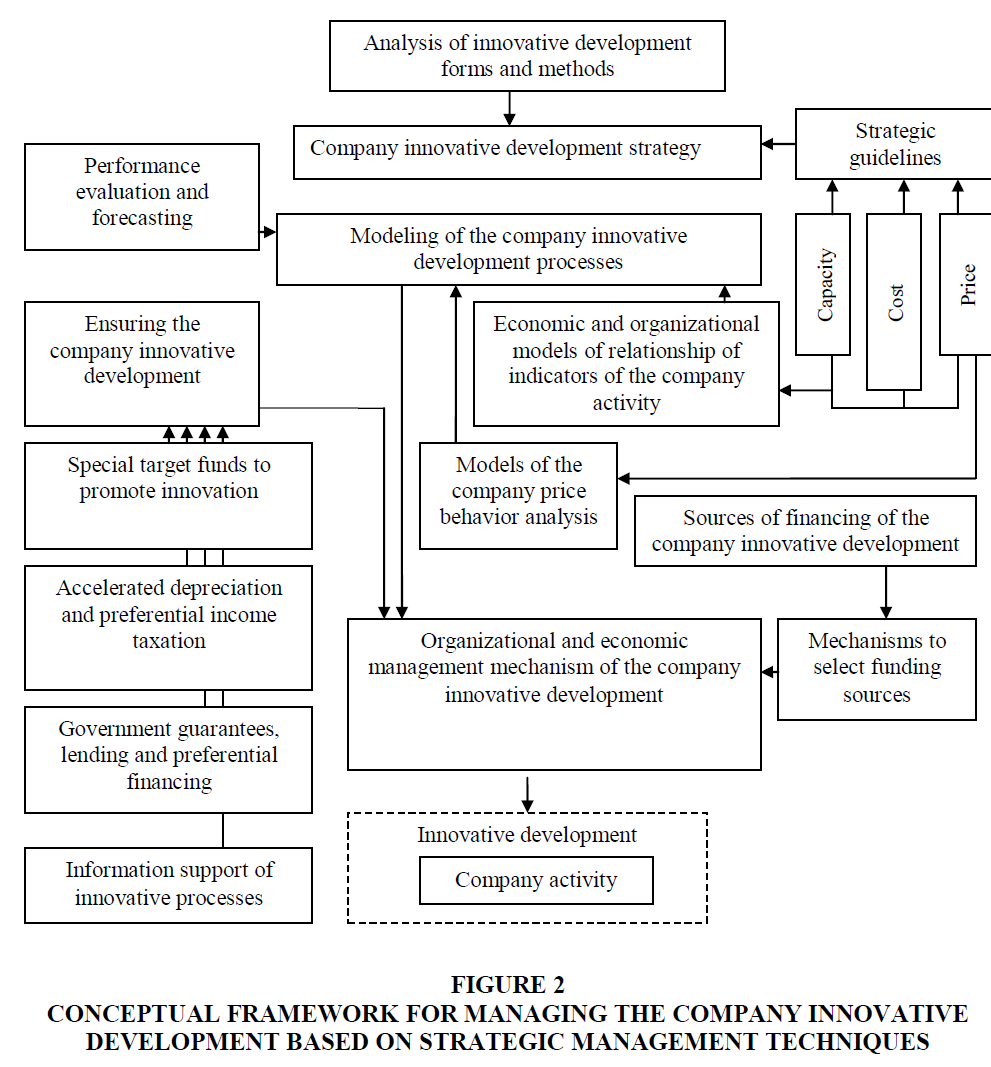Research Article: 2019 Vol: 18 Issue: 1
Company Innovative Development Based on the Strategic Management Concept
Oksana Katsero, Dragomanov National Pedagogical University
Yevhen Kuzmenko, Dragomanov National Pedagogical University
Svitlana Tytynnik, Poltava State Agrarian Academy
Olha Kolisnyk, Kharkiv National University of Radio Electronics
Oleg Krivorotenko, Odessa National Polytechnic University
Abstract
The article determines the level of influence of strategic management on the innovative development of the company. The classification grouping of general strategies of innovative development and specific innovative strategies of expansion of commercial activity is carried out. This created the methodological basis for choosing the right strategy in certain market conditions of the company activity. A conceptual scheme for managing the innovative development of the company was developed based on the methodology of strategic management.
Keywords
Innovative Development, Strategic Management, Strategic Guidelines, Innovation Strategy, Resulting Indicators.
JEL Classifications
M21
Introduction
The relevance of the article is due to the fact that innovation is one of the most important means of ensuring the sustainable development of the company over the short and long term. Innovative development and strategies have a positive direct or indirect impact on the volume of manufacture and sales of production, manufacturing and sales expenses, which is reflected in the increase in the level of competitiveness of production and demand for it. Ultimately, these changes provide growth in the profitability and cost effectiveness of the company, as well as shape its strategic advantages and market stability.
Literature Review
The issues of strategic and innovative development management are discussed in the works of (Assink, 2006; Hamel, 2002). A wide range of issues related to innovation activity management is presented in the works of (Karpenko et al., 2018; Lendel et al., 2015). The status of a company innovation strategy in the structure of its strategic set (portfolio of competitiveness assurance system) is presented in the works of (Darroch, 2005; Varmus, 2009). Scientists point out that identifying and choosing an appropriate innovation strategy is a key issue in strategic management (Svitlana et al., 2019).
Methodology
The research methodology is based on scientific findings and logical conclusions that developing and implementing innovative strategies for companies ensures their high level of competitiveness and profitability, and significantly stimulates R&D processes. In fact, the developed and implemented innovative strategies, which, in our opinion, determine the logic of the overall (corporate, portfolio) effect and business behavior of the company based on innovation, are bound to serve this.
Findings and Discussion
The innovation strategy has a dual horizontal and functional character and can be represented, on the one hand, as a regulator of the functioning of the innovation sector, and on the other hand, as a functional strategy. In this regard, it is necessary to develop appropriate strategies for managing innovation development, in which to anticipate the various aspects of improving all types of activities, to take into account the evaluation criteria for management in the economic and industrial structure (Figure 1; Bature et al., 2018).
The above classification is based on such characteristic features of a strategy as: the way to achieve the goal of innovative development of a company, which is set before its management and can be changed in any period of time at different levels of management; orientation to a certain direction of development of a company; development of a strategy of innovative development with application of searching methods; transition to a different strategy if the expected goals are met; mandatory use of feedback (Vaccaro et al., 2012).
Analysis of strategic guidelines will enable the implementation of intrasystem and market strategies, for which increasing the level of cost effectiveness by improving the efficiency of production capacity utilization remains the main criterion. In our opinion, it is advisable to distinguish three groups of applied and most successful innovative strategies of a company depending on the strategic goal (Table 1). Innovative strategies of a company:
| Table 1 Types of Innovation Strategies Depending on the Strategic Goal of the Company | |
| Innovation strategy goal | Innovation strategies |
| Advanced growth | Advanced growth strategies aimed at the development and implementation of fundamentally new products and processes: 1) Offensive strategy 2) New market creation 3) Strategy of waiting for a leader. |
| Gradual growth | Gradual growth strategies based on the application of radical and enhancing innovation: 1) Kaizen (continuous improvement) strategy 2) Licensing strategy. |
| Market positioning | Market positioning strategies that imply the launch of sophisticated products and technologies: 1) Imitation strategy 2) Defensive strategy 3) Adoption strategy. |
1) Advanced growth strategies aimed at the development and implementation of fundamentally new “breakthrough” products and processes (high innovation radicality);
2) Gradual growth strategies based on the application of radical and enhancing innovation;
3) Market positioning strategies that imply the launch of sophisticated products and technologies (low innovation radicality).
In order to achieve the set strategic goals, it is necessary to follow the innovative strategy that corresponds to the innovative potential of the company. In the case of increasing the innovation potential, an adjustment of the innovation strategy is required.
Innovation strategy of advanced growth assumes high radicalization of implemented innovations and considerable or average innovative potential (Kleinknecht, 1993). The lack of separate elements of innovation potential requires prior growth and development. The advanced growth strategy is related with a high risk but it can provide the company with significant competitive advantage and high revenues.
It is advisable to choose the innovative strategy of gradual growth in cases of: low innovation potential with high innovation radicality; average innovative potential with average innovation radicality; significant innovation potential with low innovation radicality. This innovation strategy is less risky than the advanced growth strategy, but the revenue level is lower. The strategy of market positioning can be chosen in the case of low and medium radicality of innovations implemented with little innovation potential (Mol & Birkinshaw, 2009). The alternation of these strategies can form the basis of interaction within the production chain and scientific and technical training.
The innovation management mechanism is always aimed at achieving specific innovation goals by acting on the factors that ensure their achievement. The mechanism of company innovative development management depends on the subjects of innovation. Subjects of innovation can act as innovators generating new ideas or as imitators who reproduce new (someone else's idea) ideas.
The dilemma of “to imitate or not to imitate” is always faced by companies experiencing a lack of technology. As a rule, companies start out as imitators and then learn (Makedon, 2019). Although imitation is a primary action, understanding the imitation will vary from company to company. For some companies, imitation will be a strategy, and for some, a short-term tactic. The achieving of the set objectives can be combined into a single goal, by means of creating a conceptual framework (Figure 2).
Figure 2 Conceptual Framework for Managing the Company Innovative Development Based on Strategic Management Techniques
Implementation of the research results helps to reduce the level of R&D expenditures and gives the opportunity to create a set of organizational and economic measures aimed at activation of the company innovative activity.
Recommendations
As a practical guide, we create a methodical approach that the company innovation strategy will be considered successful if it leads to the creation and launch of a new product that will sell well. Therefore, it is necessary to use the synergy of different tools for managing the innovation system of the company in order to maximize "overlapping" the disadvantages of one method by the advantages of another. Each company must make its own choice of methodology and tools but we want to draw attention to the fact that a comprehensive approach to solving management problems is the most effective.
Conclusion
The concept of innovative development of the company is formulated, which combines objectives that include the development of methodological recommendations regarding the use of the innovative model of development of the company, the formation of production capacities at the stage of scientific and technical preparation of production taking into account the future level of their use; the need to use scientific and technological preparation of production for innovative development. It is proved that the process of developing a strategy of innovative development of the company is a series of sequential measures with the mandatory presence of feedbacks, which allow carrying out the adjustment of goals and objectives, to form the resulting indicators.
References
- Assink, M. (2006). Inhibitors of disruptive innovation capability: a conceptual model. European Journal of Innovation Management, 9(2), 215-233.
- Bature, S.W., Sallehuddin, R.M., Rosli, N.A., & Saad, S. (2018). Proactiveness, innovativeness and firm performance: the mediating role of organizational capability. Academy of Strategic Management Journal.
- Darroch, J. (2005). Knowledge management, innovation and firm performance. Journal of Knowledge Management, 9(3), 101-115.
- Hamel, G. (2002). Leading the revolution, Plume. New York, NY. Holt, Rinehart, and Winston, New York, NY.
- Karpenko, L.M., Serbov, M., Kwilinski, A., Makedon, V., & Drobyazko, S. (2018). Methodological platform of the control mechanism with the energy saving technologies. Academy of Strategic Management Journal, 17(5), 1-7.
- Kleinknecht, A. (1993). Why do we need new innovation output indicators? An introduction. In New concepts in innovation output measurement. Palgrave Macmillan, London.
- Lendel, V., Hittmár, Š., & Siantová, E. (2015). Management of innovation processes in company. Procedia Economics and Finance, 23, 861-866.
- Makedon, V., Drobyazko, S., Shevtsova, H., Maslosh, O., & Kasatkina, M. (2019). Providing security for the development of high-technology organizations. Journal of Security & Sustainability Issues, 8(4).
- Mol, M.J., & Birkinshaw, J. (2009). The sources of management innovation: When firms introduce new management practices. Journal of Business Research, 62(12), 1269-1280.
- Svitlana, B., Liliya, B., Oksana, K., & Inna, G. (2019). Modelling instruments in risk management. Crisis, 6, 9.
- Vaccaro, I.G., Jansen, J.J., Van Den Bosch, F.A., & Volberda, H.W. (2012). Management innovation and leadership: The moderating role of organizational size. Journal of Management Studies, 49(1), 28-51.
- Varmus, M. (2009). Comparison of selected concepts strategies. Theory of Management, 1, 169-173.

